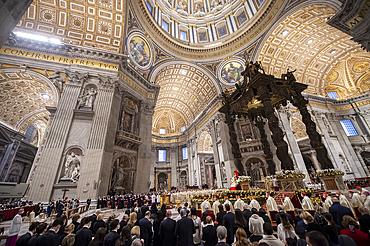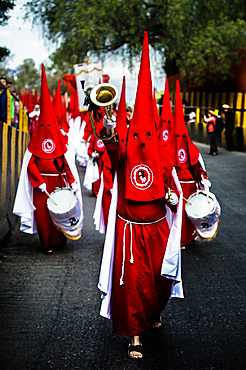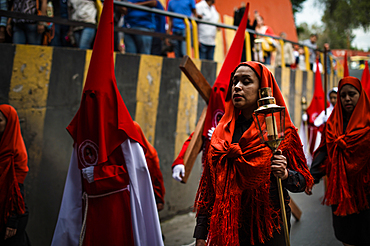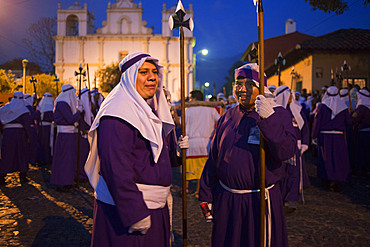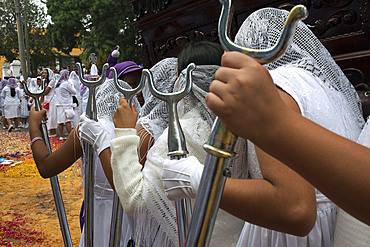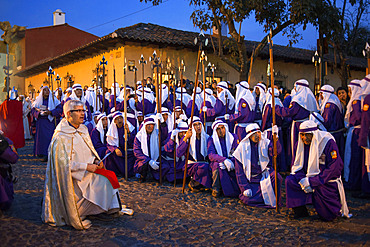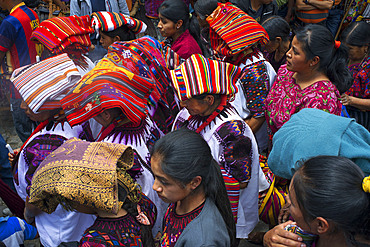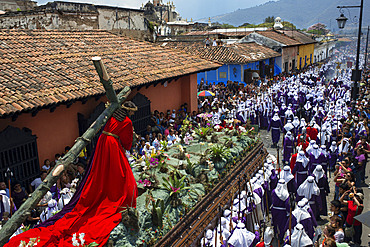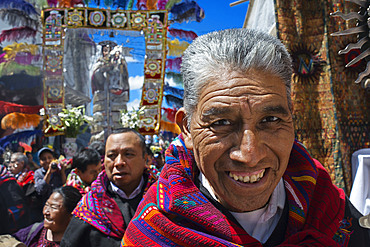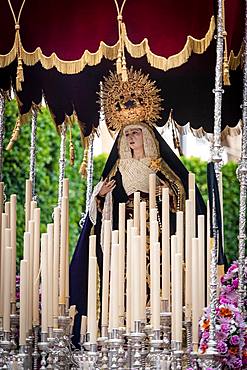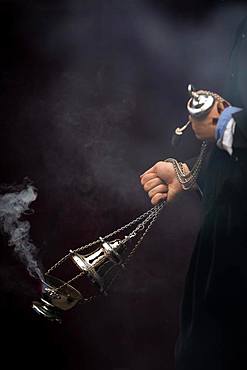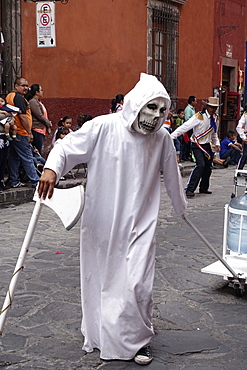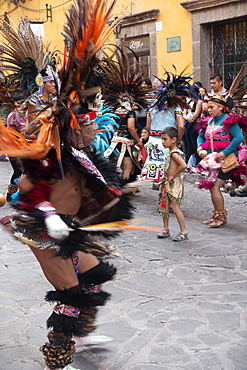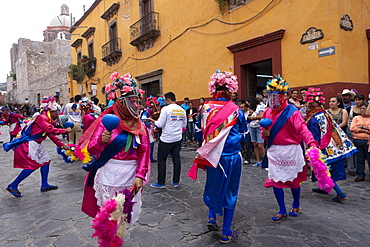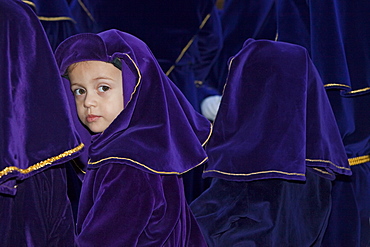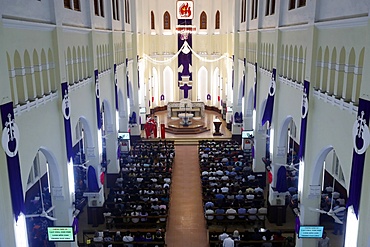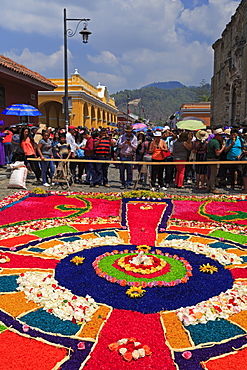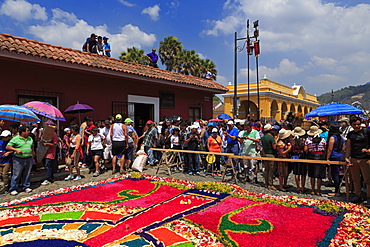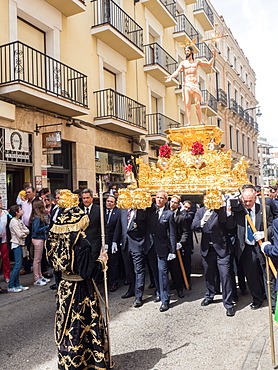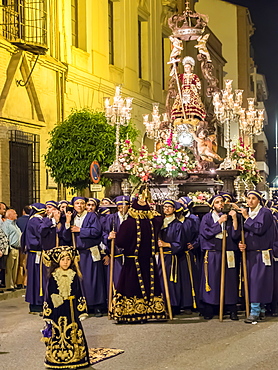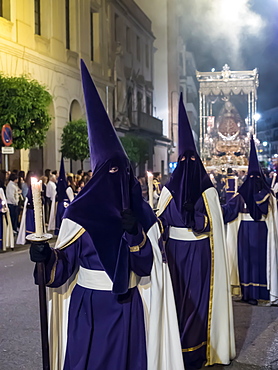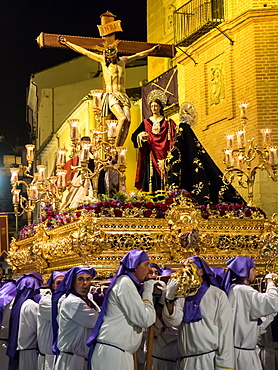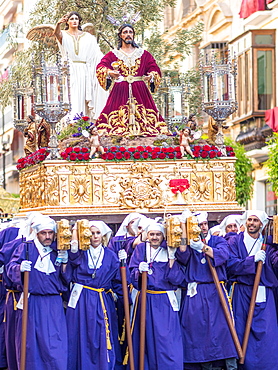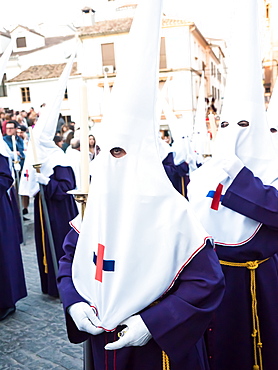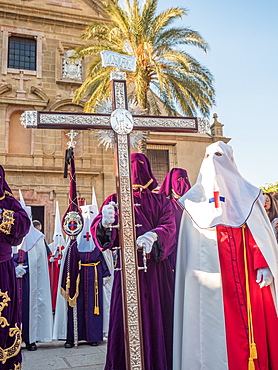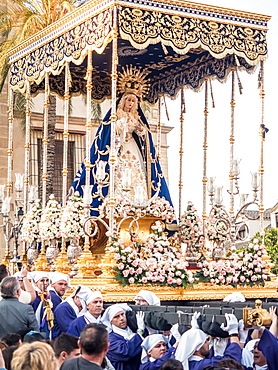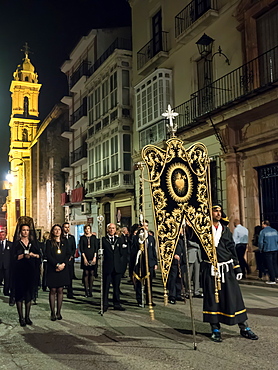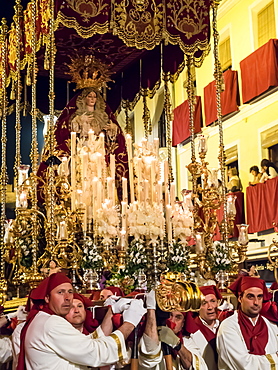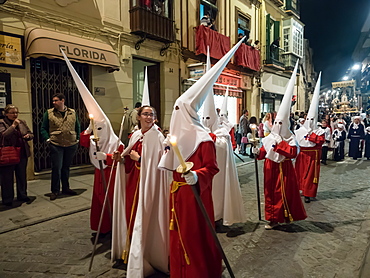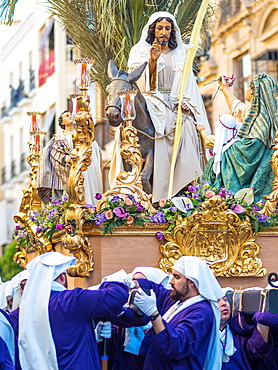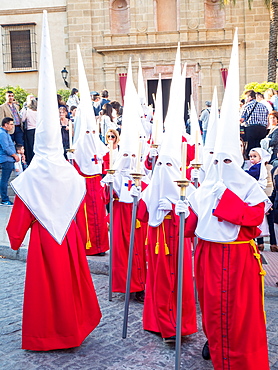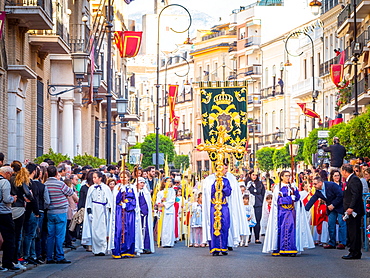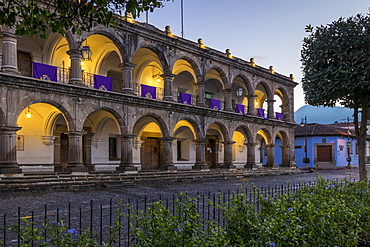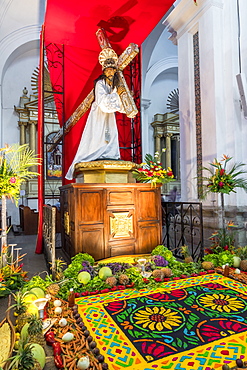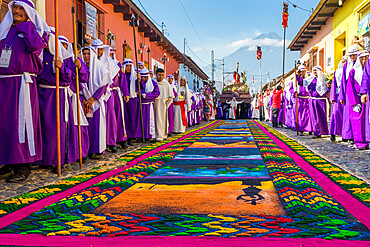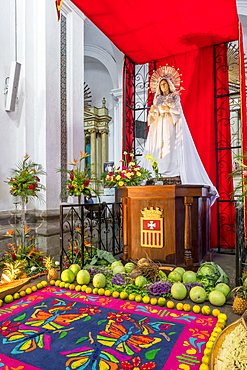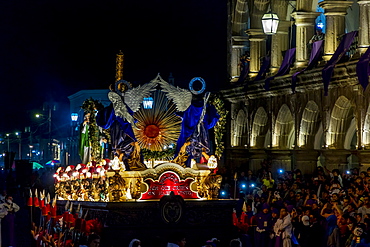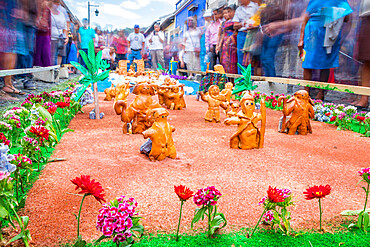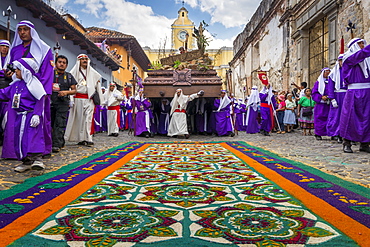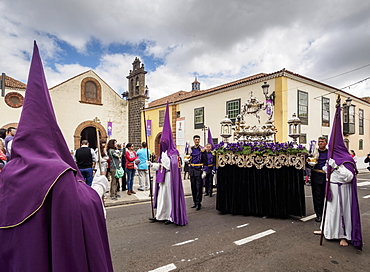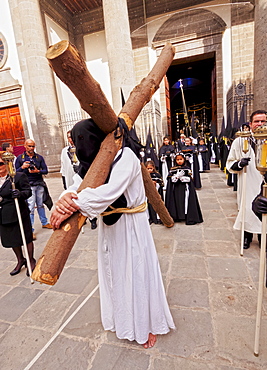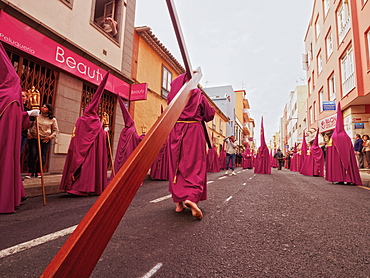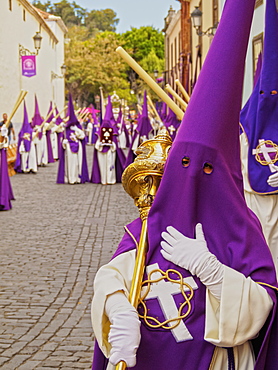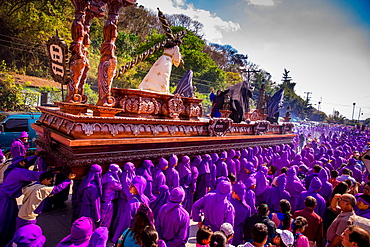Recent searches
Loading...
809-8543 - Pope Francis presides over the Easter Vigil in St. Peter's Basilica, UNESCO World Heritage Site, Christians around the world marking Holy Week, Vatican, Rome, Lazio, Italy, Europe
809-8542 - Pope Francis leads Palm Sunday, marking the final Sunday of Lent, the beginning of Holy Week, St. Peters, UNESCO World Heritage Site, Vatican, Rome, Lazio, Italy, Europe
1350-6046 - Bishop blessing the palms,mass,Palm Sunday.Interior of Basilica Sagrada Familia, Barcelona, Catalonia, Spain
1350-5075 - Other participants include adults and children in various dress which include altar boys, Nazarenes,
1350-5170 - For almost 60 years, about two thousand people from 28 different guilds (associations of faithful Catholics) come together on Good Friday to participate in this procession, carrying emblems, religious images concerning the Stations of the Cross, and dressed in the distinctive colors of their guilds, Each one of the ,??Guilds,?? carries an image with a picture of Jesus Christ,??s Stations of the Cross and of the mysteries of the Holy Rosary,
1350-5273 - Among them there are also differences Nazarenes, some are barefoot and harder doing his penance, others bearing crosses, there are those who carry various representative elements of the brotherhood, musical objects, candles, etc,
1350-5256 - For almost 60 years, about two thousand people from 28 different guilds (associations of faithful Catholics) come together on Good Friday to participate in this procession, carrying emblems, religious images concerning the Stations of the Cross, and dressed in the distinctive colors of their guilds, Each one of the ,??Guilds,?? carries an image with a picture of Jesus Christ,??s Stations of the Cross and of the mysteries of the Holy Rosary,
1350-5124 - Women wearing traditional Potosi rebozos and carrying candles,
1350-5140 - Among them there are also differences Nazarenes, some are barefoot and harder doing his penance, others bearing crosses, there are those who carry various representative elements of the brotherhood, musical objects, candles, etc,
1350-5118 - Women wearing traditional Potosi rebozos and carrying candles,
1350-5134 - For almost 60 years, about two thousand people from 28 different guilds (associations of faithful Catholics) come together on Good Friday to participate in this procession, carrying emblems, religious images concerning the Stations of the Cross, and dressed in the distinctive colors of their guilds, Each one of the ,??Guilds,?? carries an image with a picture of Jesus Christ,??s Stations of the Cross and of the mysteries of the Holy Rosary,
1350-5275 - Women wearing traditional Potosi rebozos and carrying candles,
1350-5073 - Women wearing traditional Potosi rebozos and carrying candles,
1350-5074 - Women wearing traditional Potosi rebozos and carrying candles,
1350-5271 - Women wearing traditional Potosi rebozos and carrying candles,
1350-5144 - There are twenty three main platform, with the end of the procession marked by that dedicated to Our Lady of Solitude also called ,??La Dolorosa,?? because of the expression her face takes on upon seeing her dead Son, The statue is carried by around 40 men, carrying upon their shoulders a weight of over a ton,
1350-5146 - For almost 60 years, about two thousand people from 28 different guilds (associations of faithful Catholics) come together on Good Friday to participate in this procession, carrying emblems, religious images concerning the Stations of the Cross, and dressed in the distinctive colors of their guilds, Each one of the ,??Guilds,?? carries an image with a picture of Jesus Christ,??s Stations of the Cross and of the mysteries of the Holy Rosary,
1350-5072 - Among them there are also differences Nazarenes, some are barefoot and harder doing his penance, others bearing crosses, there are those who carry various representative elements of the brotherhood, musical objects, candles, etc,
1350-5257 - Among them there are also differences Nazarenes, some are barefoot and harder doing his penance, others bearing crosses, there are those who carry various representative elements of the brotherhood, musical objects, candles, etc,
1350-5099 - The participants, called ,??costaleros,??, have their head covered by a long, pointed hood adding drama to the action,
1350-5114 - Women wearing traditional Potosi rebozos and carrying candles,
1350-5264 - There are twenty three main platform, with the end of the procession marked by that dedicated to Our Lady of Solitude also called ,??La Dolorosa,?? because of the expression her face takes on upon seeing her dead Son, The statue is carried by around 40 men, carrying upon their shoulders a weight of over a ton,
1350-5188 - Women wearing traditional Potosi rebozos and carrying candles,
1350-5088 - Among them there are also differences Nazarenes, some are barefoot and harder doing his penance, others bearing crosses, there are those who carry various representative elements of the brotherhood, musical objects, candles, etc,
1350-5254 - Among them there are also differences Nazarenes, some are barefoot and harder doing his penance, others bearing crosses, there are those who carry various representative elements of the brotherhood, musical objects, candles, etc,
809-8261 - Catholic Mass, Holy week, Eucharist celebration, Saint Joseph des Fins Church, Annecy, Haute-Savoie, France, Europe
1350-3758 - Easter Holy Week procession in Antigua, Guatemala. Jesus Nazareno de la Penitencia Procession in Antigua, Guatemala. Holy Week, friday.
1350-2688 - Verges, a small town in the Northeast of Catalonia (Spain), during Easter celebrates the Procession of Verges with skeletons dancing on the sound of a drum, Roman soldiers, known as the 'Manages', and a representation of the life and crucifixion of Jesus Christ. The Procession features the Dance of Death, a tradition from the Middle Age associated with epidemics and plagues and the only one remaining in Spain Ten skeletons dance to the beat of a drum to remember that no one is exempt of death. The backdrop of the medieval walls and towers of Verges is key to this macabre staging.
1350-3754 - A boy spreads incense at the Jesus Nazareno del Perdon procession during Easter Holy Week in Antigua Guatemala. Holy Week (Semana Santa) carpet of colored sawdust (alfombras) being prepared on Antigua street. Jesus Nazareno de la Penitencia Procession in Antigua, Guatemala.
1350-2693 - Verges, a small town in the Northeast of Catalonia (Spain), during Easter celebrates the Procession of Verges with skeletons dancing on the sound of a drum, Roman soldiers, known as the 'Manages', and a representation of the life and crucifixion of Jesus Christ. The Procession features the Dance of Death, a tradition from the Middle Age associated with epidemics and plagues and the only one remaining in Spain Ten skeletons dance to the beat of a drum to remember that no one is exempt of death. The backdrop of the medieval walls and towers of Verges is key to this macabre staging.
1350-2692 - Verges, a small town in the Northeast of Catalonia (Spain), during Easter celebrates the Procession of Verges with skeletons dancing on the sound of a drum, Roman soldiers, known as the 'Manages', and a representation of the life and crucifixion of Jesus Christ. The Procession features the Dance of Death, a tradition from the Middle Age associated with epidemics and plagues and the only one remaining in Spain Ten skeletons dance to the beat of a drum to remember that no one is exempt of death. The backdrop of the medieval walls and towers of Verges is key to this macabre staging.
1350-2695 - Verges, a small town in the Northeast of Catalonia (Spain), during Easter celebrates the Procession of Verges with skeletons dancing on the sound of a drum, Roman soldiers, known as the 'Manages', and a representation of the life and crucifixion of Jesus Christ. The Procession features the Dance of Death, a tradition from the Middle Age associated with epidemics and plagues and the only one remaining in Spain Ten skeletons dance to the beat of a drum to remember that no one is exempt of death. The backdrop of the medieval walls and towers of Verges is key to this macabre staging.
1350-3751 - Holy Week processions in Guatemala city. Holy Thursday. Holy Week in Guatemala is celebrated with street expressions of faith, called processions, usually organized by a "hermandades". Each procession of Holy Week has processional floats and steps, which are often religious images of the Passion of Christ, or Marian images, although there are exceptions, like the allegorical steps of saints.
1350-3777 - Chichicastenango, Quiche, Guatemala, Central America. Processions of Festival of Santo Thomas. On Easter Sunday The Comrades (Council Men) Carry The Andas (Floats) Of The Saints In Procession From The Santo Tomas
1350-3760 - Easter Holy Week procession in Antigua, Guatemala. Jesus Nazareno de la Penitencia Procession in Antigua, Guatemala. Holy Week, friday.
1350-2690 - Verges, a small town in the Northeast of Catalonia (Spain), during Easter celebrates the Procession of Verges with skeletons dancing on the sound of a drum, Roman soldiers, known as the 'Manages', and a representation of the life and crucifixion of Jesus Christ. The Procession features the Dance of Death, a tradition from the Middle Age associated with epidemics and plagues and the only one remaining in Spain Ten skeletons dance to the beat of a drum to remember that no one is exempt of death. The backdrop of the medieval walls and towers of Verges is key to this macabre staging.
1350-3778 - Chichicastenango, Quiche, Guatemala, Central America. Typical women hats during Holy Week processions.
1350-3753 - Holy Week processions in Guatemala city. Holy Thursday. Comparsa. Holy Week in Guatemala is celebrated with street expressions of faith, called processions, usually organized by a "hermandades". Each procession of Holy Week has processional floats and steps, which are often religious images of the Passion of Christ, or Marian images, although there are exceptions, like the allegorical steps of saints.
1350-2691 - Verges, a small town in the Northeast of Catalonia (Spain), during Easter celebrates the Procession of Verges with skeletons dancing on the sound of a drum, Roman soldiers, known as the 'Manages', and a representation of the life and crucifixion of Jesus Christ. The Procession features the Dance of Death, a tradition from the Middle Age associated with epidemics and plagues and the only one remaining in Spain Ten skeletons dance to the beat of a drum to remember that no one is exempt of death. The backdrop of the medieval walls and towers of Verges is key to this macabre staging.
1350-2687 - Verges, a small town in the Northeast of Catalonia (Spain), during Easter celebrates the Procession of Verges with skeletons dancing on the sound of a drum, Roman soldiers, known as the 'Manages', and a representation of the life and crucifixion of Jesus Christ. The Procession features the Dance of Death, a tradition from the Middle Age associated with epidemics and plagues and the only one remaining in Spain Ten skeletons dance to the beat of a drum to remember that no one is exempt of death. The backdrop of the medieval walls and towers of Verges is key to this macabre staging.
1350-3763 - Easter Holy Week procession in Antigua, Guatemala. Jesus Nazareno de la Penitencia Procession in Antigua, Guatemala. Holy Week, friday.
1350-2689 - Verges, a small town in the Northeast of Catalonia (Spain), during Easter celebrates the Procession of Verges with skeletons dancing on the sound of a drum, Roman soldiers, known as the 'Manages', and a representation of the life and crucifixion of Jesus Christ. The Procession features the Dance of Death, a tradition from the Middle Age associated with epidemics and plagues and the only one remaining in Spain Ten skeletons dance to the beat of a drum to remember that no one is exempt of death. The backdrop of the medieval walls and towers of Verges is key to this macabre staging.
1350-2696 - Verges, a small town in the Northeast of Catalonia (Spain), during Easter celebrates the Procession of Verges with skeletons dancing on the sound of a drum, Roman soldiers, known as the 'Manages', and a representation of the life and crucifixion of Jesus Christ. The Procession features the Dance of Death, a tradition from the Middle Age associated with epidemics and plagues and the only one remaining in Spain Ten skeletons dance to the beat of a drum to remember that no one is exempt of death. The backdrop of the medieval walls and towers of Verges is key to this macabre staging.
1350-2697 - Verges, a small town in the Northeast of Catalonia (Spain), during Easter celebrates the Procession of Verges with skeletons dancing on the sound of a drum, Roman soldiers, known as the 'Manages', and a representation of the life and crucifixion of Jesus Christ. The Procession features the Dance of Death, a tradition from the Middle Age associated with epidemics and plagues and the only one remaining in Spain Ten skeletons dance to the beat of a drum to remember that no one is exempt of death. The backdrop of the medieval walls and towers of Verges is key to this macabre staging.
1350-2694 - Verges, a small town in the Northeast of Catalonia (Spain), during Easter celebrates the Procession of Verges with skeletons dancing on the sound of a drum, Roman soldiers, known as the 'Manages', and a representation of the life and crucifixion of Jesus Christ. The Procession features the Dance of Death, a tradition from the Middle Age associated with epidemics and plagues and the only one remaining in Spain Ten skeletons dance to the beat of a drum to remember that no one is exempt of death. The backdrop of the medieval walls and towers of Verges is key to this macabre staging.
1350-3775 - Chichicastenango, Quiche, Guatemala, Central America. Processions of Festival of Santo Thomas. On Easter Sunday The Comrades (Council Men) Carry The Andas (Floats) Of The Saints In Procession From The Santo Tomas
832-385196 - Paso de la Virgen, statue of the Virgin Mary with canopy, Semana Santa procession, Holy Week, Almeria, Andalusia, Spain, Europe
832-385195 - Silver incense barrel with steaming incense is swivelled, Semana Santa, Holy Week, Almeria, Andalusia, Spain, Europe
745-129 - Native Dancers, Semana Santa (Holy Week), San Miguel de Allende, Mexico, North America
745-131 - Native Dancer as Death, Semana Santa (Holy Week), San Miguel de Allende, Mexico, North America
745-133 - Native Indigenous Dancers, Semana Santa (Holy Week), San Miguel de Allende, Mexico, North America
745-132 - Native Dancers, Parade of Semana Santa (Holy Week), San Miguel de Allende, Mexico, North America
794-1168 - Semana Santa (Holy Week) celebrations, Malaga, Andalucia, Spain, Europe
809-7541 - Catholic Mass on Good Friday of Holy Week, Gia Dinh Church, Ho Chi Minh City (Saigon), Vietnam, Indochina, Southeast Asia, Asia
809-7542 - Catholic Mass on Good Friday of Holy Week, Gia Dinh Church, Ho Chi Minh City (Saigon), Vietnam, Indochina, Southeast Asia, Asia
776-5334 - Alfrombras for Holy Week Procession, Antigua City, Guatemala, Central America
776-5335 - Alfrombras for Holy Week Procession, Antigua City, Guatemala, Central America
776-5338 - Alfrombras for Holy Week, Antigua City, Guatemala, Central America
1242-165 - Antequera is known for traditional Semana Santa (Holy Week) processions leading up to Easter, Antequera, Andalucia, Spain, Europe
1242-168 - Antequera, known for traditional Semana Santa (Holy Week) processions leading up to Easter, Antequera, Andalucia, Spain, Europe
1242-166 - Antequera, known for traditional Semana Santa (Holy Week) processions leading up to Easter, Antequera, Andalucia, Spain, Europe
1242-164 - Antequera, known for traditional Semana Santa (Holy Week) processions leading up to Easter, Antequera, Andalucia, Spain, Europe
1242-163 - Antequera, known for traditional Semana Santa (Holy Week) processions leading up to Easter, Antequera, Andalucia, Spain, Europe
1242-162 - Antequera, known for traditional Semana Santa (Holy Week) processions leading up to Easter, Antequera, Andalucia, Spain, Europe
1242-160 - Antequera, known for traditional Semana Santa (Holy Week) processions leading up to Easter, Antequera, Andalucia, Spain, Europe
1242-167 - Antequera, known for traditional Semana Santa (Holy Week) processions leading up to Easter, Antequera, Andalucia, Spain, Europe
1242-151 - Antequera, known for traditional Semana Santa (Holy Week) processions leading up to Easter, Antequera, Andalucia, Spain, Europe
1242-156 - Antequera, known for traditional Semana Santa (Holy Week) processions leading up to Easter, Antequera, Andalucia, Spain, Europe
1242-152 - Antequera, known for traditional Semana Santa (Holy Week) processions leading up to Easter, Antequera, Andalucia, Spain, Europe
1242-153 - Antequera, known for traditional Semana Santa (Holy Week) processions leading up to Easter, Antequera, Andalucia, Spain, Europe
1242-159 - Antequera, known for traditional Semana Santa (Holy Week) processions leading up to Easter, Antequera, Andalucia, Spain, Europe
1242-154 - Antequera, known for traditional Semana Santa (Holy Week) processions leading up to Easter, Antequera, Andalucia, Spain, Europe
1242-158 - Antequera, known for traditional Semana Santa (Holy Week) processions leading up to Easter, Antequera, Andalucia, Spain, Europe
1242-157 - Antequera, known for traditional Semana Santa (Holy Week) processions leading up to Easter, Antequera, Andalucia, Spain, Europe
1242-150 - Antequera, known for traditional Semana Santa (Holy Week) processions leading up to Easter, Antequera, Andalucia, Spain, Europe
1242-155 - Antequera, known for traditional Semana Santa (Holy Week) processions leading up to Easter, Antequera, Andalucia, Spain, Europe
1242-149 - Antequera, known for traditional Semana Santa (Holy Week) processions leading up to Easter, Antequera, Andalucia, Spain, Europe
1242-161 - Antequera, known for traditional Semana Santa (Holy Week) processions leading up to Easter, Antequera, Andalucia, Spain, Europe
1283-387 - The fountain at the main square with view to the San Jose Cathedral during Holy Week, Antigua, Sacatepequez, Guatemala, Central America
1283-236 - The town of Antigua decorated with banners for the Holy Week at dusk, Antigua, UNESCO World Heritage Site, Guatemala, Central America
1283-181 - Vigil on Holy Thursday during the Holy Week 2017 inside the Cathedral San Jose in Antigua, Guatemala, Central America
1283-188 - Good Friday procession approaching a sawdust carpet during Holy Week 2017 in Antigua, Guatemala, Central America
1283-190 - High-angle view over the Holy Tuesday Procession leaving the chapel El Calvario near Antigua during Holy Week 2017, Antigua, Guatemala, Central America
1283-182 - Vigil on Holy Thursday during the Holy Week 2017 inside the Cathedral San Jose in Antigua, Guatemala, Central America
1283-184 - Nightly procession passing at the town hall of Antigua on Holy Thursday during the Holy Week 2017, Antigua, Guatemala, Central America
1283-183 - Good Friday procession in the streets of Antigua during Holy Week 2017, Antigua, Guatemala, Central America
1283-189 - Sawdust carpet for the Good Friday procession during Holy Week 2017 in Antigua, Guatemala, Central America
1283-187 - Sawdust carpet for the Good Friday procession during Holy Week 2017 in Antigua, Guatemala, Central America
1283-172 - Floats for the Holy Week processions of the Company of Jesus in Antigua, Guatemala, Central America
1283-6 - Good Friday Procession approaching a sawdust carpet during Holy Week 2017 in Antigua, Guatemala, Central America
1245-895 - Traditional Easter Holy Week Procession in San Cristobal de la Laguna, Tenerife Island, Canary Islands, Spain, Europe
1245-896 - Traditional Easter Holy Week Procession in San Cristobal de la Laguna, Tenerife Island, Canary Islands, Spain, Europe
1245-893 - Traditional Easter Holy Week Procession in San Cristobal de la Laguna, Tenerife Island, Canary Islands, Spain, Europe
1245-894 - Traditional Easter Holy Week Procession in San Cristobal de la Laguna, Tenerife Island, Canary Islands, Spain, Europe
1245-897 - Traditional Easter Holy Week Procession in San Cristobal de la Laguna, Tenerife Island, Canary Islands, Spain, Europe
1245-898 - Traditional Easter Holy Week Procession in San Cristobal de la Laguna, Tenerife Island, Canary Islands, Spain, Europe
1245-892 - Traditional Easter Holy Week Procession in San Cristobal de la Laguna, Tenerife Island, Canary Islands, Spain, Europe
857-92993 - Bercianos De Aliste, Castilla and Leon, Spain. Traditional robed and hooded penitents from the 'Santo Entierro' brotherhood take part in a religious procession on Holy Friday in Bercianos de Aliste
1218-122 - Holy Week Carpetas Parade, Antigua, Guatemala, Central America
